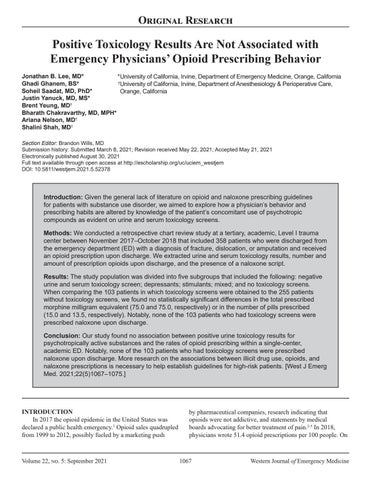Original Research
Positive Toxicology Results Are Not Associated with Emergency Physicians’ Opioid Prescribing Behavior Jonathan B. Lee, MD* *University of California, Irvine, Department of Emergency Medicine, Orange, California † Ghadi Ghanem, BS* University of California, Irvine, Department of Anesthesiology & Perioperative Care, Soheil Saadat, MD, PhD* Orange, California Justin Yanuck, MD, MS* Brent Yeung, MD† Bharath Chakravarthy, MD, MPH* Ariana Nelson, MD† Shalini Shah, MD† Section Editor: Brandon Wills, MD Submission history: Submitted March 8, 2021; Revision received May 22, 2021; Accepted May 21, 2021 Electronically published August 30, 2021 Full text available through open access at http://escholarship.org/uc/uciem_westjem DOI: 10.5811/westjem.2021.5.52378
Introduction: Given the general lack of literature on opioid and naloxone prescribing guidelines for patients with substance use disorder, we aimed to explore how a physician’s behavior and prescribing habits are altered by knowledge of the patient’s concomitant use of psychotropic compounds as evident on urine and serum toxicology screens. Methods: We conducted a retrospective chart review study at a tertiary, academic, Level I trauma center between November 2017–October 2018 that included 358 patients who were discharged from the emergency department (ED) with a diagnosis of fracture, dislocation, or amputation and received an opioid prescription upon discharge. We extracted urine and serum toxicology results, number and amount of prescription opioids upon discharge, and the presence of a naloxone script. Results: The study population was divided into five subgroups that included the following: negative urine and serum toxicology screen; depressants; stimulants; mixed; and no toxicology screens. When comparing the 103 patients in which toxicology screens were obtained to the 255 patients without toxicology screens, we found no statistically significant differences in the total prescribed morphine milligram equivalent (75.0 and 75.0, respectively) or in the number of pills prescribed (15.0 and 13.5, respectively). Notably, none of the 103 patients who had toxicology screens were prescribed naloxone upon discharge. Conclusion: Our study found no association between positive urine toxicology results for psychotropically active substances and the rates of opioid prescribing within a single-center, academic ED. Notably, none of the 103 patients who had toxicology screens were prescribed naloxone upon discharge. More research on the associations between illicit drug use, opioids, and naloxone prescriptions is necessary to help establish guidelines for high-risk patients. [West J Emerg Med. 2021;22(5)1067–1075.]
INTRODUCTION In 2017 the opioid epidemic in the United States was declared a public health emergency.1 Opioid sales quadrupled from 1999 to 2012, possibly fueled by a marketing push
Volume 22, no. 5: September 2021
by pharmaceutical companies, research indicating that opioids were not addictive, and statements by medical boards advocating for better treatment of pain.2-5 In 2018, physicians wrote 51.4 opioid prescriptions per 100 people. On
1067
Western Journal of Emergency Medicine
